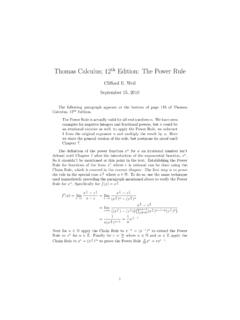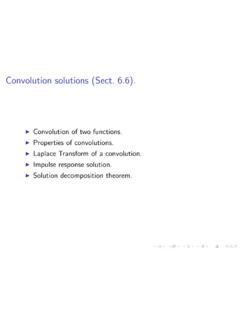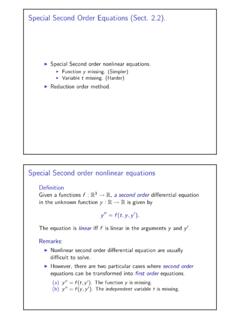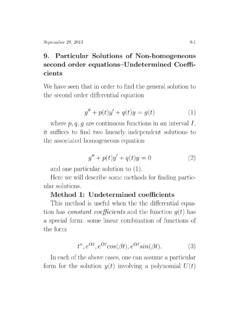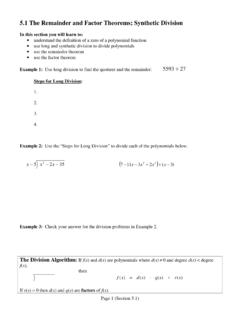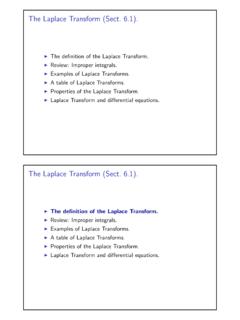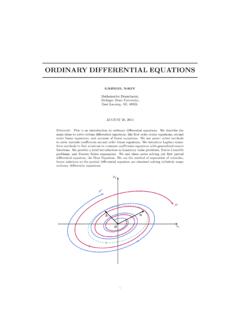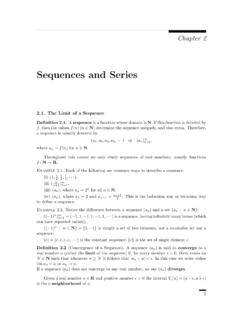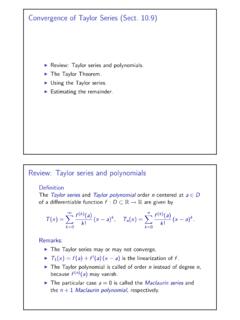Transcription of LINEAR ALGEBRA - Michigan State University
1 LINEAR ALGEBRAGABRIEL NAGYM athematics Department, Michigan State University ,East Lansing, MI, 15, are the lecture notes for the course MTH 415, Applied LINEAR ALGEBRA ,a one semester class taught in 2009-2012. These notes present a basic introduction tolinear ALGEBRA with emphasis on few applications. Chapter1introduces systems of linearequations, the Gauss-Jordan method to find solutions of these systems which transformsthe augmented matrix associated with a LINEAR system into reduced echelon form, wherethe solutions of the LINEAR system are simple to obtain. We end the Chapter with two ap-plications of LINEAR systems: First, to find approximate solutions to differential equationsusing the method of finite differences; second, to solve LINEAR systems using floating-pointnumbers, as happens in a computer.
2 Chapter2reviews matrix ALGEBRA , that is, we in-troduce the LINEAR combination of matrices , the multiplication of appropriate matrices ,and the inverse of a square matrix. We end the Chapter with the LU-factorization of amatrix. Chapter3reviews the determinant of a square matrix, the relation between anon-zero determinant and the existence of the inverse matrix, a formula for the inversematrix using the matrix of cofactors, and the Cramer rule for the formula of the solu-tion of a LINEAR system with an invertible matrix of coefficients. The advanced part ofthe course really starts in Chapter4with the definition of vector spaces, subspaces, thelinear dependence or independence of a set of vectors, bases and dimensions of vectorspaces. Both finite and infinite dimensional vector spaces are presented, however finitedimensional vector spaces are the main interest in this notes.
3 Chapter5presents lineartransformations between vector spaces, the components of a LINEAR transformation in abasis, and the formulas for the change of basis for both vector components and transfor-mation components. Chapter6introduces a new structure on a vector space, called aninner product. The definition of an inner product is based on the properties of the dotproduct inRn. We study the notion of orthogonal vectors, orthogonal projections, bestapproximations of a vector on a subspace, and the Gram-Schmidt orthonormalizationprocedure. The central application of these ideas is the method of least-squares to findapproximate solutions to inconsistent LINEAR systems. One application is to find the bestpolynomial fit to a curve on a plane.
4 Chapter8introduces the notion of a normed space,which is a vector space with a norm function which does not necessarily comes from aninner product. We study the main properties of thep-norms onRnorCn, which areuseful norms in functional analysis. We briefly discuss induced operator norms. The lastSection is an application of matrix norms. It discusses the condition number of a matrixand how to use this information to determine ill-conditioned LINEAR systems. Finally,Chapter9introduces the notion of eigenvalue and eigenvector of a LINEAR operator. Westudy diagonalizable operators, which are operators with diagonal matrix componentsin a basis of its eigenvectors. We also study functions of diagonalizable operators, withthe exponential function as a main example.
5 We also discuss how to apply these ideasto find solution of LINEAR systems of ordinary differential : July 15, NAGY LINEAR ALGEBRA July 15, 2012 ITable of ContentsOverview1 Notation and conventions1 Acknowledgments2 Chapter 1. LINEAR Row and column Row Column Gauss-Jordan The augmented Gauss elimination Square Echelon Echelon and reduced echelon The rank of a Inconsistent LINEAR Non-homogeneous Matrix-vector Linearity of matrix-vector Homogeneous LINEAR The span of vector Non-homogeneous LINEAR Floating-point Main The rounding Solving LINEAR Reducing rounding Exercises42 Chapter 2. Matrix LINEAR A matrix is a A matrix is a LINEAR LINEAR LINEAR combination of The transpose, adjoint, and trace of a LINEAR transformations on Matrix Algebraic Matrix Main Block multiplication62 IIG.
6 NAGY LINEAR ALGEBRA july 15, Matrix Inverse Main Properties of invertible Computing the inverse Null and range Definition of the Main Gauss Main A sufficient Solving LINEAR Exercises90 Chapter 3. Definitions and Determinant of 2 2 Determinant of 3 3 Determinant ofn Inverse matrix Cramer s Determinants and Gauss Exercises107 Chapter 4. Vector Spaces and The span of finite ALGEBRA of Internal direct LINEAR Linearly dependent Main Bases and Basis of a vector Dimension of a vector Extension of a set to a The dimension of subspace Vector Ordered bases131G. NAGY LINEAR ALGEBRA July 15, Vector components in a Exercises136 Chapter 5.
7 LINEAR LINEAR The null and range Injections, surjections and Nullity-Rank Properties of LINEAR The inverse The vector space of LINEAR LINEAR functionals and the dual The ALGEBRA of LINEAR Polynomial functions of LINEAR Functions of LINEAR The commutator of LINEAR Transformation The matrix of a LINEAR Action as matrix-vector Composition and matrix Change of Vector Transformation Determinant and trace of LINEAR Exercises175 Chapter 6. Inner product Dot Dot product Dot product Inner Inner Inner product Norm Orthogonal Definition and Orthonormal Vector Orthogonal Orthogonal projection onto Orthogonal Exercises205 IVG.
8 NAGY LINEAR ALGEBRA july 15, Gram-Schmidt The adjoint The Riesz Representation The adjoint Normal Bilinear Exercises216 Chapter 7. Approximation Best Fourier Null and range spaces of a Least The normal Least squares LINEAR Finite difference Differential Difference Method of finite Finite element Differential The Galerkin Finite element Exercises244 Chapter 8. Normed Not every norm is an inner product Equivalent Operator Condition Exercises265 Chapter 9. Spectral Eigenvalues and Main Characteristic Eigenvalue Operators with distinct Diagonalizable operators275G. NAGY LINEAR ALGEBRA July 15, Eigenvectors and Functions of diagonalizable The exponential of diagonalizable Differential Non-repeated real Non-repeated complex Normal Exercises300 Chapter 10.
9 Review Practice Answers to Solutions to Practice Exams336 References356G. NAGY LINEAR ALGEBRA July 15, 20121 OverviewLinear ALGEBRA is a collection of ideas involving algebraic systems of LINEAR equations,vectors and vector spaces, and LINEAR transformations between vector equations are called a system when there is more than one equation, and theyare called LINEAR when the unknown appears as a multiplicative factor with power zero or example of a LINEAR system of two equations in two unknowns is given in Eqs. ( )-( )below. Systems of LINEAR equations are the main subject of of vectors are oriented segments on a line, plane, or space. An oriented segmentis an ordered pair of points in these sets. Such ordered pair can be drawn as an arrow thatstarts on the first point and ends on the second point.
10 Fix a preferred point in the line, planeor space, called the origin point, and then there exists a one-to-one correspondence betweenpoints in these sets and arrows that start at the origin point. The set of oriented segmentswith common origin in a line, plane, and space are calledR,R2andR3, sketch of vectors in these sets can be seen in Two operations are defined onoriented segments with common origin point: An oriented segment can be stretched orcompressed; and two oriented segments with the same origin point can be added using theparallelogram law. An addition of several stretched or compressed vectors is called a linearcombination. The set of all oriented segments with common origin point together with thisoperation of LINEAR combination is the essential structure called vector space.
